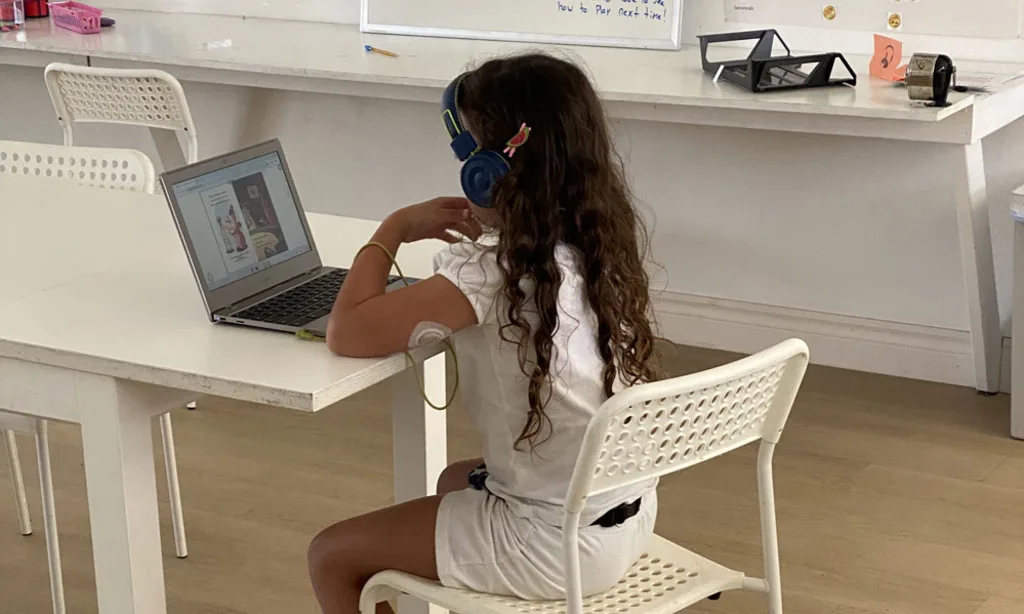Homeschoolers embrace AI, even as many educators are wary
Homeschoolers embrace AI, even as many educators are wary
Once you persuade parents and kids to use AI, ‘there’s nobody else you have to convince.’
BY Greg Toppo
Like many parents who homeschool their children, Jolene Fender helps organize book clubs, inviting students in her Cary, North Carolina, co-op to meet for monthly discussions.
But over the years, parents have struggled to find good opening questions.
“You’d search [the internet], you’d go on Pinterest,” she said. “A lot of the work had to be done manually, or you had to do a lot more digging around.”
Then came ChatGPT, Open AI’s widely used artificial intelligence bot. For Fender, it was a no-brainer to query it for help developing deep opening questions.
The chatbot and other AI tools like it have found an eager audience among homeschoolers and microschoolers, with parents and teachers readily embracing it as a brainstorming and management tool, even as public schools take a more cautious approach, often banning it outright.
A few observers say AI may even make homeschooling more practical, opening it up to busy parents who might have balked previously.
“Homeschoolers have always been unconstrained in their ability to combine technology—any kind of tech,” said Alex Sarlin, a longtime technology analyst and cohost of the EdTech Insiders podcast.
The reasons are readily apparent, he said: Home internet service typically doesn’t block key websites the way most schools do. Families can more easily manage data privacy and get the digital tools they want without fuss. They’re basically able to ignore “all the dozen reasons why everything falls apart when you try to sell to schools,” Sarlin said.
Persuading homeschoolers to try out new things is also a lot simpler: If a student and parents like a tool, “there’s nobody else you have to convince.”
Indeed, a September survey by the curriculum vendor Age of Learning found that 44% of homeschool educators reported using ChatGPT compared to 34% of classroom educators.
“Not everyone is using it, but some are very excited about it,” said Amir Nathoo, cofounder of Outschool, an online education platform.
The most interesting uses he has seen are by gifted and neurodiverse homeschoolers, who often use chatbots to explore complex topics like advanced math and science, philosophy and even ethics, which they wouldn’t ordinarily have access to at a young age. They ask it to provide simple explanations of advanced topics, such as relativity and quantum mechanics, then pursue them on their own. “They’re able to go on a relatively unstructured exploration, which is often the best way that kids learn.”
Alternatively, he said, kids whose ability to express themselves is limited can also benefit from what many consider the nonjudgmental qualities of tools like ChatGPT.
Peer-to-peer learning
Tobin Slaven, cofounder of Acton Academy, a self-paced, independent microschool in Fort Lauderdale, Florida, said he’s been experimenting with AI tools for the past year or so and is excited by what he’s seen. “This is what the future looks like to me,” he said.
Like many educators, he sees the problems inherent in AI tools like ChatGPT, which on occasion “hallucinate” with incorrect information and can sometimes be downright creepy. These concerns have stopped many families from fully embracing AI.
But Slaven can’t support banning it outright. Instead, he’ll offer a student his own device with ChatGPT loaded onto a browser window. The entire time, he has access to their queries and results. That ensures he can review the sessions for inappropriate content.

Lately, Slaven and his students have been playing with an AI tool called Pathfinder that helps them create and develop projects. Designed by a small, two-person U.K.-based startup, it’s set up like a simple chatbot that asks students what they want to learn about. It elicits information, much like a Socratic guide, about their prior knowledge and how they’d like to explore the topic. Then it searches the internet for appropriate resources and returns suggestions on what to do next.
Pathfinder uses Open AI’s GPT-4 large language model and its own algorithm to rank resources based on how relevant it is to an individual learner, said cofounder Amaan Ahmad. That includes how they learn best, what they’re interested in, and what they already know.
After a number of students in a homeschool group or class have worked with it long enough, it can even begin recommending classmates or friends to consult with to learn how they’re approaching the topic.
“My AI can talk to your AI and say, ‘Hey, Greg crushed that last week. Why don’t you go speak to him and develop your project together?’” he said.
Slaven tried out Pathfinder with a group of students recently and found that even during a brief trial run, it allowed them to better conceptualize their projects.
With the tool asking them questions about their preferred topic, they were able to go from general inquiries about their interests, such as horseback riding or space exploration, to more advanced ones that explore the topics more deeply. That goes a long way toward helping students become more independent and responsible for their own learning, a key goal of microschooling and homeschooling.
Slaven believes, more broadly, that AI copilots configured to students’ interests and preferences will enable personalized learning at scale. It’ll become the norm that everyone has a collaborative AI partner that will, in time, understand how each student performs best and under what conditions. “It’s eventually going to become their preferred resource,” he said.
Making homeschooling more accessible
Ahmad, the Pathfinder cofounder, said AI holds the possibility of helping endeavors like microschooling and homeschooling become more practical. Access to reliable, safe AI agents means that an individual student isn’t restricted to what a parent or teacher knows.
Giving that autonomy with a bit of guidance helps make learning much more impactful, he said. “It’s very difficult to do that in real time because the one adult with one kid, you can’t always be by their side. And if you have a microschool with 12 to 16 kids, that’s even more time-consuming.”
For Fender, the North Carolina homeschooling mother, one of the most helpful aspects of AI is that it helps parents organize what can often be a chaotic, free-form learning environment.
Fender subscribes to a type of homeschooling known as “unschooling,” which seeks to teach students to be more self-directed and independent than in most public schools. Her kids’ lessons are “very much interest-led” and her small co-op has grown in recent years.
But she must also persuade state bureaucrats that she’s providing an adequate education. So she and a few other homeschool parents in Cary rely on a website that uses AI to detail what activities their kids have done and auto-completes all the relevant North Carolina educational standards. “I thought that was a genius tool,” she said, and one that allows stressed, busy parents to build a comprehensive portfolio for annual state reviews and high school transcripts.
Fender also uses ChatGPT for brainstorming. In a recent case, which she shared on Instagram, Fender asked the AI for 50 real-life applications for the Pythagorean theorem. It generated a list that included designing ramps or stairs, planning optimal pathways in garden design, and building efficient roller coasters.
Last year, she recalled, one of her daughters was creating Christmas cards for a homeschool craft fair and “wanted to have fun puns in the cards.” Fender explained how to craft an AI prompt—and how to sift through the chaff. Her daughter eventually asked ChatGPT for 50 different Christmas-themed puns and ended up using about 10 to 15.
Like most parents, Fender has read about the downsides of AI but believes schools are short-sighted to limit its use.
“Why are you banning a tool that is definitely here to stay?” she said. “Maybe we don’t understand all the ins and outs, but at the end of the day, our goal is to prepare kids for the jobs of the future. And a lot of these jobs of the future, we don’t even know what they are.”
This article was also published at The74Million.org, a nonprofit education news site.
ABOUT THE AUTHOR
Fast Company
(6)



